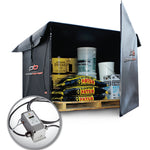You have no items in your shopping cart.
Article At-a-Glance
What is Decarbonization Technology and How Does it Work?
Decarbonization technology encompasses a range of tools and methods, such as increasing energy efficiency, transitioning to renewable energy sources, and implementing carbon capture and storage, all aimed at reducing or eliminating carbon dioxide emissions from energy production and industrial processes to achieve net-zero emissions.
Key Takeaways
- Define Decarbonization Technology: Understand decarbonization technology as a suite of tools and methods aimed at reducing or eliminating carbon dioxide emissions from energy production and industrial processes, crucial for achieving net-zero emissions.
- Explore Key Technologies: Learn about pivotal technologies such as electrification, green hydrogen, and carbon capture and storage (CCS) that are transforming industries by minimizing reliance on fossil fuels and reducing carbon footprints.
- Discover Practical Applications: Examine real-world examples and case studies where decarbonization technologies have been successfully implemented, showcasing their benefits in reducing emissions and enhancing operational efficiency.
- Stay Updated on Innovations: Keep abreast of the latest trends and cutting-edge developments in decarbonization, including advancements in renewable energy integration and energy efficiency improvements, driving the transition to sustainable practices.
- Understand Industry Impact: Recognize the significant role decarbonization technology plays in reshaping industrial processes, from manufacturing to energy production, contributing to a more sustainable and environmentally friendly future.
Advancing Eco-Friendly Processes with Decarbonization Technology
Decarbonization is what many industries are focused on as more efforts are made to push back against man-made climate change. Read the summary immediately below or the main article further down to find out how your organization can play an important role in creating a sustainable solution.
Article Summary:
What is decarbonization technology?
Decarbonization technology refers to a variety of tools and methods used to reduce or eliminate carbon dioxide emissions from energy production and industrial processes.
What are the four pillars of decarbonization?
- Increasing energy efficiency
- Transitioning to renewable energy sources
- Carbon capture and storage
- Developing new low-carbon technologies
What are the three main decarbonization strategies?
- Electrification: Replacing fossil fuels with electricity generated from renewable sources.
- Hydrogen utilization: Using green hydrogen as a clean fuel source for industrial processes.
- Carbon capture, utilization, and storage (CCUS): Capturing carbon dioxide emissions and storing them underground or utilizing them for other purposes.
What are the techniques of decarbonization?
- Improving energy efficiency in industrial processes
- Switching to renewable energy sources for electricity and heat generation
- Implementing carbon capture and storage technology
- Utilizing green hydrogen as a fuel source
- Developing new low-carbon technologies

$1,600.50 USD
Core FR1-24 Cplg for use on Ruffneck FR Series Heater
For reliable and energy-efficient heating solutions in decarbonization efforts, explore products by Ruffneck, Norseman, Cata-Dyne, and Caloritech.
What is Decarbonization?
The industrial sector is a significant contributor to greenhouse gas emissions. To combat climate change and create a more sustainable future, industries are increasingly turning to decarbonization technology. Decarbonization refers to the process of reducing or eliminating carbon dioxide emissions from energy production and industrial processes. This technology plays a crucial role in helping industries achieve their environmental goals and become more sustainable.
For industries with significant heating and cooling needs, decarbonization technology is particularly relevant. Industrial heating, or traditional methods of heating and cooling, often rely on fossil fuels, which contribute heavily to carbon emissions. According to the U.S. Department of Energy:
Industrial heating refers to the many methods by which heat is used to transform materials into useful products. Heat is used to remove moisture, separate chemicals, create steam, treat metals, melt plastics, and much more. Industrial heating accounts for about 9% of the entire U.S. [carbon] emissions footprint.
Decarbonization technology offers alternative solutions that can significantly reduce a company's carbon footprint. These same measures also can offer cost savings and waste reduction that help companies run more efficiently.

Understanding Decarbonization Technology
In simple terms, decarbonization technology encompasses a variety of tools and methods used to decrease the carbon intensity of an industrial process. This can be achieved through several approaches, including:
- Increasing energy efficiency: By optimizing energy use in industrial processes, less energy is required overall, leading to a reduction in carbon emissions.
- Transitioning to renewable energy sources: Replacing fossil fuels with renewable energy sources like solar, wind, geothermal, and hydropower eliminates carbon emissions associated with fuel combustion.
- Carbon capture and storage (CCS): CCS technology captures carbon dioxide emissions from industrial processes and stores them underground, preventing them from entering the atmosphere.
The ultimate goal of decarbonization is to achieve net-zero emissions, where the amount of carbon dioxide released into the atmosphere is balanced by the amount removed. This can be achieved through a combination of the strategies mentioned above.
Core Elements of Decarbonization
Lowering the amount of carbon in the atmosphere is more than just driving less. There are two main elements of decarbonization:
- Energy Efficiency: Decarbonization technology often focuses on improving energy efficiency in industrial processes. This can involve optimizing equipment performance, upgrading to more energy-efficient machinery, and implementing better insulation and process controls. By using less energy, industries can significantly reduce their carbon footprint. Such change also has the potential for cost savings and resource reallocation to other industrial needs.
- Carbon Capture: Carbon capture technology plays a vital role in decarbonization by capturing carbon dioxide emissions from industrial processes before they are released into the atmosphere. The captured carbon dioxide can then be stored underground or utilized for other purposes (such as concrete production or bioplastics).
These elements are key to providing a future where climate change is no longer a chief concern. In addition, the technological gains from focusing on these core principles have the potential to positively impact daily living for billions of people.
The Role of Decarbonization in Industry
Decarbonization has a significant impact on how industries produce electricity and heat. Traditionally, these processes have relied heavily on fossil fuels, leading to high levels of carbon emissions. Decarbonization technology offers alternative solutions, such as:
- Renewable energy sources: Solar, wind, geothermal, and hydropower can be used to generate electricity and heat without producing significant carbon emissions. These solutions also involve job creation in new industries, such as technicians and engineers for geothermal and solar equipment.
- Green hydrogen: Hydrogen produced using renewable energy sources ( referred to as green hydrogen) is a promising alternative to fossil fuels for industrial processes. Green hydrogen can be used for heating, power generation, and various industrial applications through its creation as a byproduct of other energy sources, such as nuclear power and natural gas.
By adopting decarbonization technologies, industries can significantly reduce their carbon footprint and contribute to a more sustainable future.
Decarbonization Strategies and Technologies
Several technologies and strategies can be employed to achieve decarbonization in various industries. Here are a few examples:
- Hydrogen fuel cell vehicles: These vehicles use hydrogen as fuel to generate electricity, producing only water vapor as a byproduct.
- Energy efficiency improvements: Implementing better insulation, optimizing processes, and upgrading to energy-efficient equipment can significantly reduce energy consumption and associated carbon emissions.
- Renewable energy integration: Incorporating solar, wind, and other renewable energy sources into industrial operations can offset fossil fuel use and reduce carbon emissions.
These technologies can be particularly beneficial for energy-intensive industries such as manufacturing, chemicals, and steel production. By adopting these strategies and technologies, industries can move closer to their decarbonization goals and contribute to a more sustainable future.
Practical Applications
Numerous industries have successfully implemented decarbonization technologies, demonstrating the potential for significant emissions reductions. For example, some manufacturing facilities have achieved substantial energy savings by optimizing their production processes and adopting advanced control systems.
Combining Safety and Decarbonization Technologies with Infrared Heaters
In the heating and cooling sector, the use of infrared heaters and convection heaters powered by renewable energy sources has proven to be effective in reducing emissions. Infrared heaters, the more efficient of the two, are a key technology to aid in decarbonization efforts.

What Are Infrared Heaters?
Infrared heaters are a popular heating option that work by emitting infrared radiation, similar to the heat from the sun. This type of heat is absorbed by objects in the room, which then warm up the surrounding air. This differs from traditional convection heaters, which heat the air directly and rely on air currents to distribute warmth.
The benefits of infrared technology for explosive environments are massive. Infrared heating is a game-changer for industries trying to decarbonize that rely on safe heating equipment in explosive environments. Equipment such as Cata-Dyne explosion-proof heaters and infrared gas catalytic heaters improve energy efficiency as well, further reducing costs even as decarbonization measures are implemented.
Thermon, a leading provider of heating solutions, understands how infrared heaters reduce heat waste and the need for decarbonization. Thermon is actively working on developing innovative products that support decarbonization efforts while increasing heating efficiency.
Other providers are also creating products that are essential for safety and environmental protection, including:

Infrared heaters, such as these Caloritech models, are both energy efficient and safe in dangerous heating environments.
The Future of Decarbonization in Industrial Processes
The future of industrial decarbonization is promising, with continued advancements in technology and increasing policy support. As the cost of renewable energy continues to decline and energy storage solutions improve, industries will have greater opportunities to adopt clean energy technologies. Additionally, emerging technologies such as carbon capture and utilization will play a crucial role in achieving net-zero emissions.
To drive the transition to a more sustainable future, industries must prioritize research and development of innovative decarbonization technologies. Investing in clean energy solutions and adopting best practices allow companies to reduce their environmental impact and gain a competitive advantage in the marketplace.
Conclusion
Decarbonization technology is essential for addressing the urgent challenge of climate change and building a sustainable future. Industries can play a vital role in mitigating the impacts of global warming by reducing greenhouse gas emissions and transitioning to renewable energy sources.
Working together with industries, governments, and technology providers, we can accelerate the decarbonization process and create a cleaner, healthier planet for future generations. With brands like Ruffneck, Cata-Dyne, Norseman, and Caloritech, we have a diverse array of safe, effective, and dependable products designed to advance clean energy and support the transition toward sustainable energy sources.













